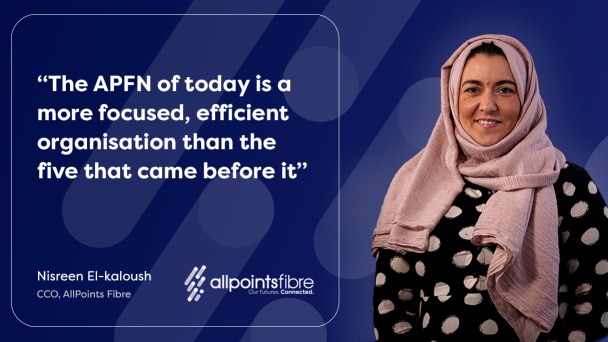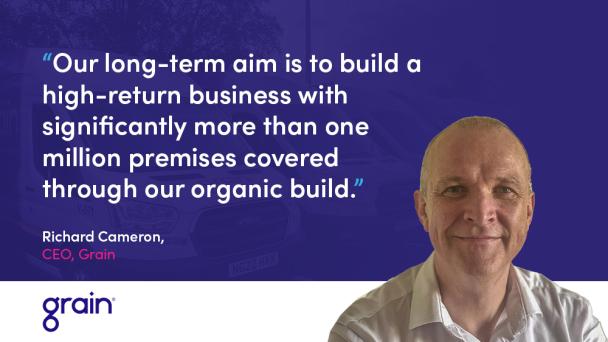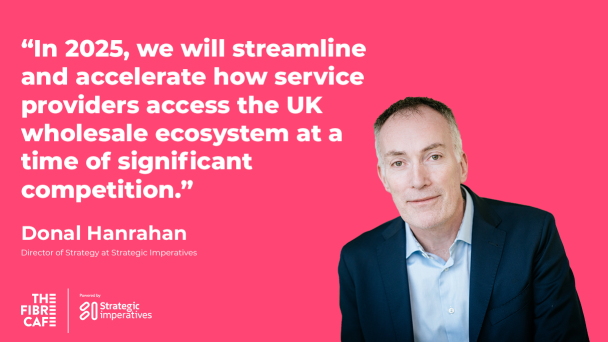2025 has proved a pivotal year for AllPoints Fibre Networks (APFN), with the completion of its consolidation programme and the launch of its wholesale fibre platform reflecting the full transformation of disparate retail ISPs and network builders into a scaling wholesaler. Here, CCO Nisreen El-kaloush lays out the post consolidation priorities for APFN as well as its long-term ambitions in the fibre sector.

Nick Parbutt struck upon the idea behind toob while on holiday during the summer of 2017. At the time, he was serving as the Strategy and Wholesale Director at Vodafone and had noted that Openreach was reluctant to invest in full fibre.
In 2017, Vodafone was in discussion with CityFibre regarding partnership, and the rest of Europe was deploying fibre networks at pace, leaving the UK far behind. “I had a decision to make; I could encourage fibre build in the UK from my current role or take the leap to be part of the solution to deploy fibre networks in the UK,” said Parbutt.
He wrote the first toob business plan on that same holiday, but it wasn’t until March 2018 that everything aligned and, with Mike Banwell, toob, CFO, he left Vodafone to raise the capital for toob.
From this business plan, toob has expanded to pass over 150,000 premises and exceed over 20,000 customers connected, with more than 90% on the toob network and the rest on CityFibre’s network across the south coast. The altnet added 2,000 customers in August alone.
toob will continue to expand its network, moving into new towns like Fleet and Eastleigh as it completes the build in some of the other towns its operating in, like Camberley and Fareham, but its current focus is on growing its customer base.
Parbutt states: “In the current market, financing is critical. Over the last few years, the industry has enjoyed access to cheap money, but this is no longer the case.
“With risk profiles changing, investors are looking more critically at businesses and backing only those they believe have a sound strategy and the ability to execute.”
toob completed a financing round with Ares Management back in May to the tune of £160m. This commitment could be upsized to £300m to support future growth opportunities. toob continues to receive ongoing support from Amber Infrastructure Group.
“This addressed the most significant challenge the business faced,” said Parbutt. “With this in place, we can now focus on leveraging the opportunities that this has presented.
“Of course, as with any organisation, we have day-to-day challenges as we manage costs, attract new talent and grow our business. But these challenges are against the context of growth, so they are great problems to have.”
Parbutt has also noticed the lifting of challenges at a macroeconomic level. Significantly, altnet’s were plagued during their build phases by supply chain challenges driven by external factors like Covid and the war in Ukraine.
He said: “Chip shortages and problems with network components were caused by the demand for PPE and escalating energy costs. These have begun to ease in the last six months.”
The employment market is also opening from toob’s perspective, with many operators slowing their build programme and letting good staff go. Parbutt adds: “The employment market for fibre skills has improved, decreasing the pressure for toob and our contractors.”
This is not to say Parbutt’s view of the market is totally rose tinted, or the old challenges facing altnets have gone. Consumer confusion continues to hamper take up of fibre services as many end users still being served by copper falsely believe they have FTTP. Parbutt states “There needs to be more clarity around which technologies proved the best connectivity.
He said: “This confusion is primarily created by the telecoms industry itself, and we spend a great deal of time explaining what we do and defining what full fibre is to our potential customers. Once they receive the service, it becomes obvious and, for some, transformational.”
Ofcom has proposals to improve broadband information for customers, which are due to be in place by the end of the year, and this is backed up by the ASA (Advertising Standards Authority), which will adopt them for their future rulings. This will provide the industry with the opportunity to be clear with customers about the definitions of a true fibre connection compared with part fibre/part copper.
Parbutt adds: “Once this comes into effect, we have a great opportunity as an industry to be clear and consistent with customers so they can more clearly understand what they are buying. This is a long-awaited move from Ofcom and the ASA, and I hope Ofcom’s proposal delivers the outcome consumers deserve.”
In the vein of improving customer experience, Parbutt is vocal advocate of the effective implementation of One Touch Switch, which is currently scheduled for March next year. He said: “Some organisations place unnecessary barriers to prevent their customers leaving, so we need the platform implemented alongside a rigorous approach to ensure that unwanted retention cannot be allowed to continue.
“Customers need to be able to make choices without fear of being hassled or even misled into their purchasing decisions and the premise of One Touch Switch will be revolutionary for the customer experience.”




